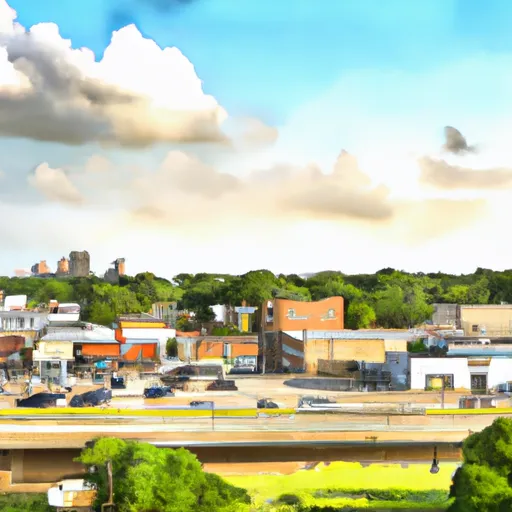-
 Snoflo Premium
Snoflo Premium
Get unlimited access to all our content
With no Ad interruptions! - Start Your Free Trial Login with existing account
Goldsboro
Eden Index
Climate
9.7
•
Recreation
2.3
•
Community
•
Safeguard
4.7/10

Goldsboro is a small town located in Texas, with a population of around 50 people. The climate in Goldsboro is classified as humid subtropical, with hot summers and mild winters. The town is situated in the Colorado River basin, and the hydrology constituents include the Colorado River and its tributaries. Outdoor recreation opportunities include hunting, fishing, and camping. Hunting is popular in the area, with opportunities to hunt deer, turkey, and wild hogs. Fishing is available in the Colorado River, with catfish and bass being the most commonly caught species. Camping is also popular in Goldsboro, with various campsites and RV parks located in the area.
What is the Eden Index?
The Snoflo Eden Index serves as a comprehensive rating system for regions, evaluating their desirability through a holistic assessment of climate health, outdoor recreation opportunities, and natural disaster risk, acknowledging the profound impact of these factors on livability and well-being.
Climate Health Indicator (CHI): 9.7
Goldsboro receives approximately
647mm of rain per year,
with humidity levels near 75%
and air temperatures averaging around
18°C.
Goldsboro has a plant hardyness factor of
8, meaning
plants and agriculture in this region tend to thrive here all year round.
By considering the ideal temperature range, reliable water supplies, clean air, and stable seasonal rain or snowpacks, the Climate Health Indicator (CHI) underscores the significance of a healthy climate as the foundation for quality living.
A healthy climate is paramount for ensuring a high quality of life and livability in a region, fostering both physical well-being and environmental harmony. This can be characterized by ideal temperatures, reliable access to water supplies, clean air, and consistent seasonal rain or snowpacks.
Weather Forecast
Streamflow Conditions
Middle Colorado-Concho
Area Rivers
Middle Colorado-Concho
Snowpack Depths
Middle Colorado-Concho
Reservoir Storage Capacity
Middle Colorado-Concho
Groundwater Levels
Recreational Opportunity Index (ROI): 2.3
The Recreational Opportunity Index (ROI) recognizes the value of outdoor recreational options, such as parks, hiking trails, camping sites, and fishing spots, while acknowledging that climate plays a pivotal role in ensuring the comfort and consistency of these experiences.
Access to outdoor recreational opportunities, encompassing activities such as parks, hiking, camping, and fishing, is crucial for overall well-being, and the climate plays a pivotal role in enabling and enhancing these experiences, ensuring that individuals can engage in nature-based activities comfortably and consistently.
Camping Areas
| Campground | Campsites | Reservations | Toilets | Showers | Elevation |
|---|---|---|---|---|---|
| Stock Pen Crossing RV Park - Menard | None | 1,884 ft | |||
| Abilene State Park | 84 | 1,986 ft | |||
| W. Lee Colburn Park | 14 | 1,814 ft | |||
| Dyess Military - Dyess AFB | 30 | 1,752 ft | |||
| Lakeside - Hords Creek Lake | 50 | 1,934 ft | |||
| Kennedy Park - O.H. Ivie Reservoir | 30 | 1,584 ft | |||
| Padgitt Park - O.H. Ivie Reservoir | None | 1,604 ft | |||
| Haskell City Park | 10 | 1,575 ft | |||
| Concho Park - O.H. Ivie Reservoir | None | 1,578 ft | |||
| Flatrock Park - Hords Creek Lake | 70 | 1,920 ft |
Nearby Fishing
Nearby Ski Areas
Catastrophe Safeguard Index (CSI):
The Catastrophe Safeguard Index (CSI) recognizes that natural disaster risk, encompassing floods, fires, hurricanes, and tornadoes, can drastically affect safety and the overall appeal of an area.
The level of natural disaster risk in a region significantly affects safety and the overall livability, with climate change amplifying these risks by potentially increasing the frequency and intensity of events like floods, fires, hurricanes, and tornadoes, thereby posing substantial challenges to community resilience and well-being.
Community Resilience Indicator (CRI):
The Community Resilience Indicator (CRI) recognizes that education, healthcare, and socioeconomics are crucial to the well-being of a region. The CRI acknowledges the profound impact of these elements on residents' overall quality of life. By evaluating educational resources, healthcare accessibility, and economic inclusivity, the index captures the essential aspects that contribute to a thriving community, fostering resident satisfaction, equity, and social cohesion.

